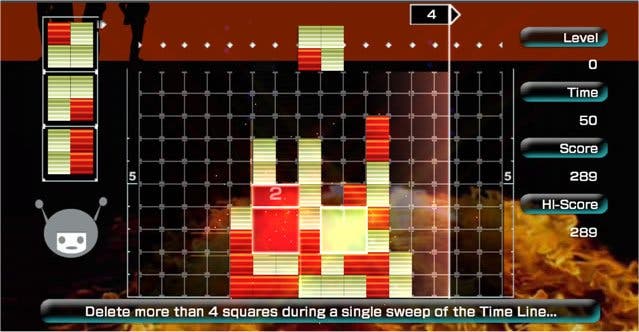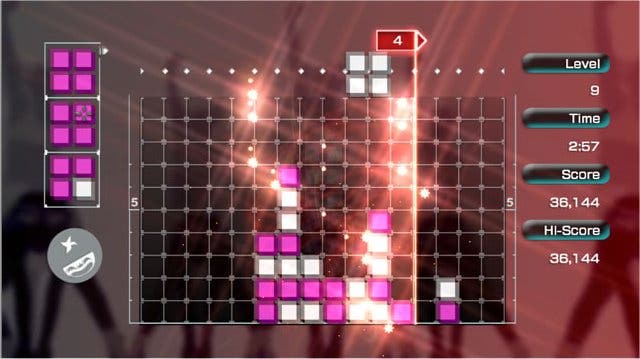Lumines Live!
Puzzle: confusion.
"If you've already played this on another platform it's not got much to offer, but for newcomers this verges on essential," is, as my friend pointed out to me last night, one of the most painful phrases a game reviewer ever has to reproduce, and yet here is where we find ourselves because, although its brilliance as a puzzle game is beyond question, Lumines' qualities are less important to the people within whose domiciles the PSP rests as commonly as the Xbox 360 (particularly those of you who stole both, because who's that at the door hide the stuff).
In fact, disillusion over its content is likely to be far more pronounced among people who own the original Lumines than is usual in these circumstances, because Q Entertainment has rather naively assumed that withholding game content will be viewed as freedom of choice, rather than a wilful decision on its part to squeeze fans for more money. It doesn't help that the basic Lumines Live package is already one of the most expensive games on Xbox Live Arcade at 1200 Microsoft points - just over a tenner in old money.
Lumines Live consists of Challenge, Skin Edit, Time Attack, Puzzle, Mission, Vs. CPU and multiplayer modes. The latter supports online Duels as well as two-player games played out on one console, and all of your scores in each mode are also uploaded to global leaderboards, allowing you to see just how good you really are (Lumines veterans will be pleased to hear that the highest recordable score is well above 999,999 this time, too). Additional content packs will be made available in the future, and this is what attracts concern. In their present form, Vs. CPU offers just one stage, while Puzzle and Mission modes both offer five stages each. Even novices will clear them all in minutes, leaving us all to wait for the "Vs. CPU Pack" and "Puzzle/Mission Pack" mentioned when you reach the end of what's included. Meanwhile, an "Advance" option in Challenge mode tells you to wait for the "Advance Pack", which will apparently add 22 new skins (which alter gameplay conditions as well as music and background) and cost 600 points.
It's safe to say that this has wound some people up.
But it's also important to talk about Lumines Live in the context of a new game, because for many people that's what it will be.

Challenge mode is where most will begin, and the premise is as simple as they come: blocks come in two colours, and when combinations of them descend from the top of the landscape-oriented rectangular play area, you have to arrange them so that the same colours form squares of two blocks' width and height. To this end you can rotate the falling blocks using the A and B buttons, and move them left and right using the d-pad or analogue stick. Where Lumines differs from the more traditional Tetris-style disappearing-blocks puzzle style is that things only vanish when a vertical line that constantly sweeps from left to right passes across completed arrangements.
It's a high-scores game, primarily, and as you play you'll gradually learn to appreciate its subtleties and become more proficient at removing larger clusters of blocks in one sweep of the vertical line. You'll work out how best to apply each possible combination of descending blocks to the landscape below (placement skills can be refined by practicing certain motions in the Puzzle and Mission modes - at least for a little while grumble grumble), or perhaps you'll build your skills around the use of specially marked blocks, which, when injected into a vanishable arrangement, will take with them any blocks of the same coloured linked directly to the matrix, and any linked, in turn, to those. Applied skilfully, these special blocks can be used to delete the entire stock of one colour, netting a 1000-point single-colour bonus. Those with a particular talent for Lumines can also net 10,000-point bonuses for removing all the blocks in the play area at once.
Adding to the attraction of the raw puzzling mechanic, which is fundamentally hypnotic anyway, are the differences made by the game's unlockable skins. As you advance through the challenge mode, building up a large points total, these new skins arrive at intervals and change the background imagery, block colours and music, but most pertinently they also change the speed of the vertical line and blocks' movement. This may force you to move blocks that appear at the top of the screen more quickly, perhaps, before they slam down irretrievably, or ask you to go slowly as a toiling vertical line ekes its way gradually from left to right.
Like creator Tetsuya Mizuguchi's previous work, music also plays an active role in augmenting the gameplay experience while you're at the mercy of these subtle reinventions. Sideways movement of a block might make a snare sound, while blocks landing on others might elicit a steadier drumming; combinations enable fancier riffs, and as the actual soundtrack song goes through its movements so the gameplay-based sounds seem to coalesce and infuse its progress with something more personal. It's a neat effect, and guarantees that new skins won't just refresh your touch but also enliven your other senses.

Q Entertainment's understood since Lumines' release on PSP two years ago that certain skins are more popular than others, and Skin Edit mode allows you to queue up "playlists" of your favourites. This is also useful for practicing the later skins if you keep coming unstuck in Challenge mode. Indeed, all the other modes are good for building up your skills in certain areas, as well as introducing variation: Time Attack gives you a good grounding in working at block structures under pressure; Vs. CPU and the online/offline multiplayer Duels do a similar job; and the Puzzle and Mission modes hone your proficiency in seeing further ahead.
The multiplayer Duels probably deserve a bit more explanation and examination. Unlike other puzzle games where your successes heap more blocks on the other player, Lumines' multiplayer puts both players in the same puzzle area, with blocks descending to the left and right of the screen on either side of a dividing line. The idea is to work quickly and efficiently to vanish blocks, which has the effect of pushing the dividing line so that it encroaches more and more on the other player's work; the goal being to inhibit them so much that their towers of blocks stretch to the top of the screen and they run out of room to add more. Played offline between balanced players, this is very aggressive, enjoyable fun, and the online experience between two players is similarly commendable - providing you're not addled by lag, which can ruin things. Played on a decent connection, it's actually better than offline, because Xbox Live's TrueSkill matchmaking software does a good job of finding similarly talented opponents rather than plunging you into endless mismatches.
Indeed, there are few missteps in the basic game as a whole. Graphically it's glossy and colourful, and sharply turned out. The music, mostly from the Japanese PSP original, is of a high standard - although I was disappointed to find some of the PSP version's best songs missing. On the PSP, some people were turned off by the demands Lumines makes on your time, with individual Challenge sessions often lasting longer than an hour and always starting the same place, but arguably Skin Edit mode goes some way to assuaging that, and, well, I can only speak for myself: I've never found it boring, and I've been playing it since December 2004. Gamerscore fans may be disappointed, meanwhile, with the achievements offering - half of which are far too easy, and a few of which are much too hard - but there's little else to fault.
Which brings us back, of course, to the question of Q Entertainment's sales tactics. Customisation is certainly welcome in some cases - being told that we'll one day be able to pick and choose famous songs, game modes that we like and new skins to flesh out the experience, without being forced to shell out for the bits we're not interested in, is an approach that sounds logical enough. The anger over the Vs. CPU, Puzzle and Mission modes' relative lack of content could be offset a little, on reflection, by the realisation that these modes aren't considered part of the basic Lumines Live package; the tasters offered as part of this release are meant to help people decide whether they want to buy these game modes or not.

The anger could perhaps be offset, then, but it probably won't be for several reasons. Firstly, Lumines Live costs more than virtually everything else on Xbox Live Arcade, and, in many cases, Lumines fans have already paid for this content before on the PSP. In a sense, they are being asked to pay more than the Live Arcade pricing standard for content they already have, and then pay extra for extra content they also already have. Not only that, but the full Vs. CPU, Puzzle and Mission modes won't exactly have taken a huge development investment to realise; the core mechanics are the same, only the arrangements and your task of untangling them is being changed around. Paying extra for accurately modelled cars in PGR3 is relatively comfortable, because they took a lot of work; paying extra for new Puzzle and Mission levels isn't, because they probably just took a few developers a few days to dream up - most of that time spent doodling rather than crafting.
Probably the only thing to say to people who feel cheated or ripped off by this tiered content set-up is that they simply shouldn't buy into Lumines Live until the range of downloadable content is broad enough to justify the cumulative cost - if indeed that happens - unless they have a powerful urge right now to play Lumines again on a big screen.
For Lumines debutantes, meanwhile, this is hard not to recommend, whatever the issues of price. The basic game outlay may be hefty relative to others on Live Arcade, but it slots reasonably into the traditional game-pricing model, where a copy of Lumines PSP stripped down to this degree probably would hold its value at around a tenner, and between them the Challenge, Time Attack and multiplayer modes are wonderfully playable. If you're new, and you can reconcile yourself with that logic, you should certainly buy this, because it will absorb you like nothing you've played in years. I'm sorry - what I meant to say is, "If you've already played this on another platform it's not got much to offer, but for newcomers this verges on essential." Gah.









